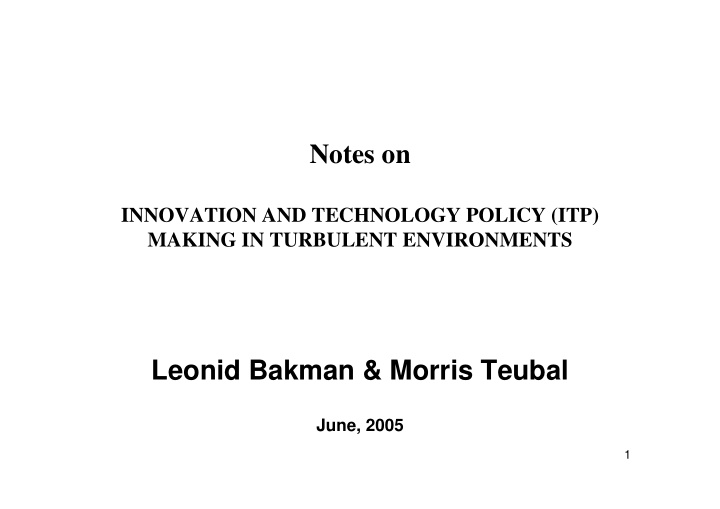



Notes on INNOVATION AND TECHNOLOGY POLICY (ITP) MAKING IN TURBULENT ENVIRONMENTS Leonid Bakman & Morris Teubal June, 2005 1
Agenda Motivation • Traditional support • Some Weaknesses • Working Assumptions • The Technology Policy Cycle • Sparking the ITP Cycle • 2
Motivation Traditional support mechanisms frequently seem to be insufficient to address present-day challenges & market/system failures 3
Traditional support • Science, technology & education (STE) infrastructure • Macroeconomic, political & institutional support ° IP, standardization & anti-trust policies ° Regulation of communications & capital markets ° Corporate governance ° International strategic collaboration • Firm level R&D/Innovation support 4
Some Weaknesses • Underlying policy/program priorities require updating • Greater links & coordination among policies are required (at a moment of time & through time) • Focus on identification of areas (sectors, product classes, technologies) where the country may possess a sustainable competitive advantages (SCA) • Governance of science, technology & innovation policy 5
Working Assumptions • Increasing turbulent environment & strong competition • SCA requires rapid building of capabilities (& possibly market share) • Strategic collaboration requirement (both domestically & internationally) • Attaining critical mass is crucial 6
THUS… Government policy should emphasize: • A clear & well defined Strategic Orientation • Multiplicity of system levels (firm, industry, nation) & the corresponding need of their link/balance • Targeting of specific technologies/sectors 7
The Technology Policy Cycle (3) (1) Policy implementation Setting the path (2) Policy design & resource allocation 8
Setting the Path (1) From national agenda to strategic vision & prioritization Determine the process & parties involved • • Generation of long term vision of the national system of innovation & technology Translating vision to ‘appropriate strategic • priorities’ 9
Setting the Path (2) Characterizing ‘Appropriate Strategic Priorities’: • Feasibility ° Based on existing capabilities ° Reflects ‘political feasibility ’ • Robustness & flexibility ° Built to last under changing internal & external environmental settings • Sustainability ° Strive to sustainable competitive advantage 10
Setting the Path (3) Determining strategic priorities: • Analyzing the internal & the external environment ° Opportunities/threats ° Capabilities assessment • Defining alternative Scenarios ° Determining the scope of activities • Formulating strategic priorities 11
Strategic Priorities in Israel 1969: Diffusion of R&D/Innovation within the Business Sector & promoting the creation, growth & development of high tech Start Up companies 1990: Transforming the High Tech Sector into a ‘Silicon Valley’ type cluster & creating a capable & networked, domestic, independent Venture Capital Industry 2005: Determining new national priorities in the Science, Technology & Innovation. Among these, enhanced & new links with emerging countries in Asia would seem to be a new priority 12
Policy Design & Resource Allocation • Policy/program evaluation • Policy comparisons & benchmarking • Identify market/system failure • Identify new required policies & their designs • Defining manageable indicators • Resource allocation & millstones definition 13
Policy Implementation • Managing the process • Dynamic Feedback ° Policy/environmental alignment ° Policy redefinition ° Policy-Business Sector Co-evolution 14
Sparking the ITP Cycle • A budget & specialized human resources • A capacity to undertake multidisciplinary work • A major issue is ITP governance; & the institutional location or positioning of the agency/institution coordinating the strategic level of ITP 15
Recommend
More recommend